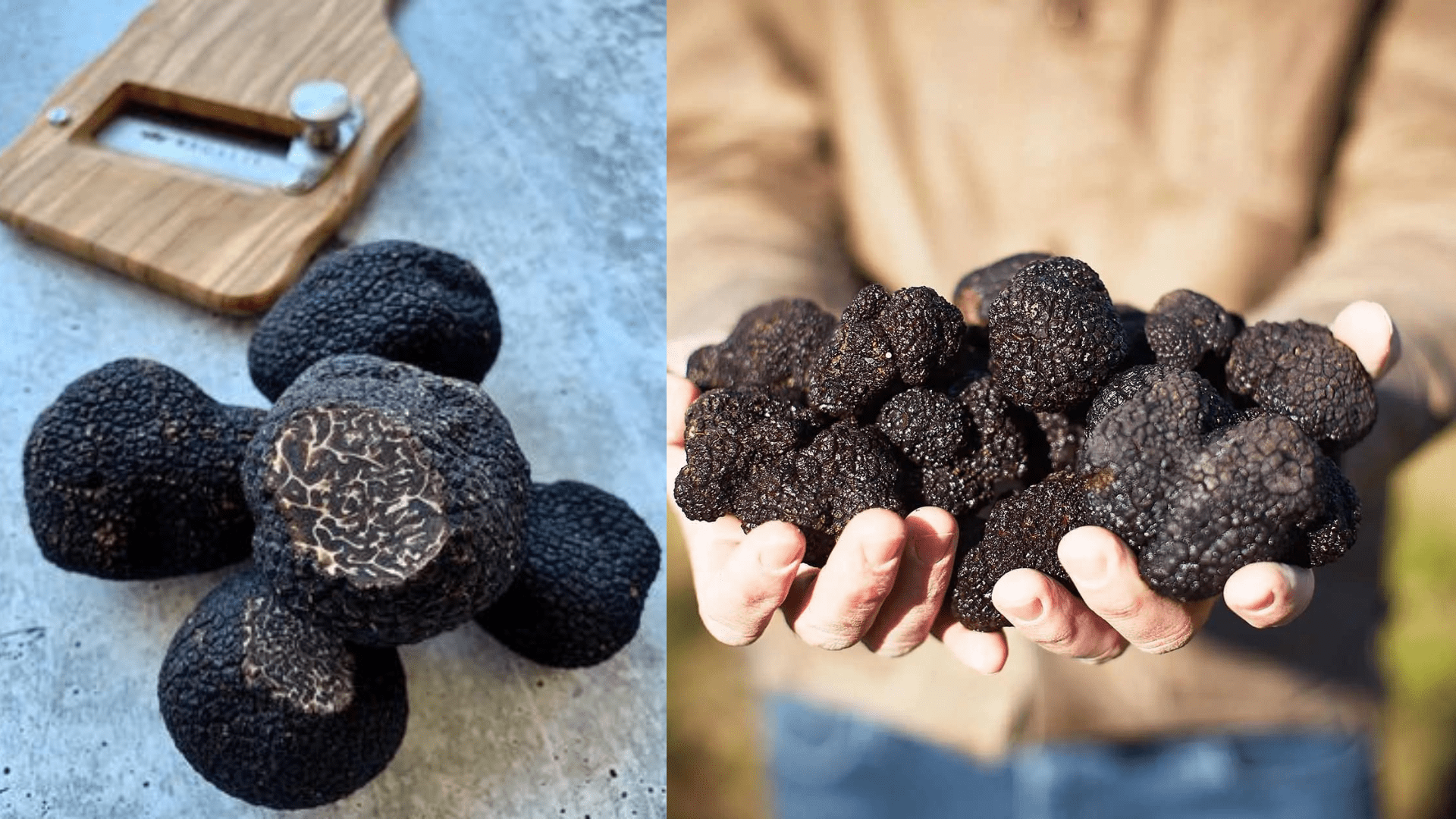Truffles are a highly prized type of edible fungi that grow underground in close symbiotic association with the roots of certain trees. There are various types of truffles, including black truffles, known for their robust flavor and often referred to as the “black diamond” of the kitchen, and white truffles, which are even more coveted for their intense aroma and ability to elevate dishes to luxurious experiences. Summer and winter truffles also exist, each with unique characteristics and culinary uses. Truffles are celebrated in the culinary world for their distinctive flavors and aromas, which can significantly enhance the taste of a wide range of dishes. Their rarity, the difficulty of cultivation, and the complex methods required for their harvest contribute to their high cost and esteemed status among gourmet ingredients.
The Allure of Truffles
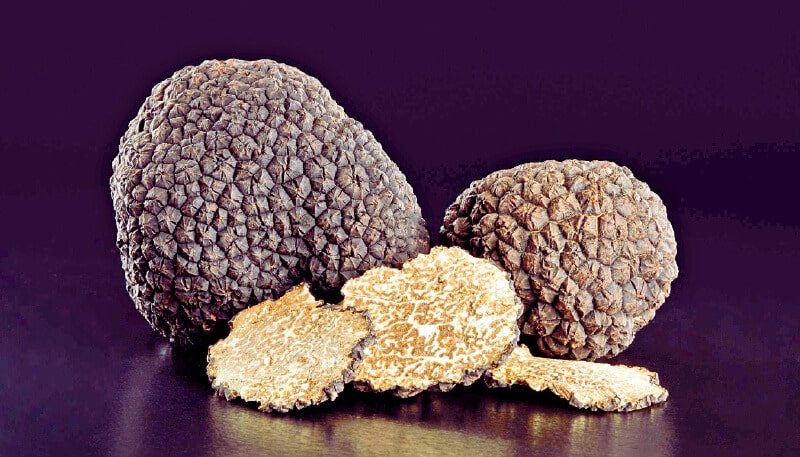
Truffles captivate food enthusiasts and chefs worldwide, commanding high prices for their unique flavors and aromas. Their allure stems from several factors:
- Rarity: Truffles are challenging to cultivate, relying on specific climates and soils to grow in a symbiotic relationship with tree roots. This makes them rare and difficult to find.
- Harvesting Difficulty: Traditionally, truffles are located and harvested with the aid of trained animals, such as pigs and dogs, adding to the labor-intensive process.
- Unique Flavor and Aroma: Truffles offer a distinctive taste and fragrance that can transform and elevate dishes, making them a sought-after ingredient in high-end cuisine.
- Supply and Demand: The limited supply, coupled with high demand from chefs and gastronomes, drives up their price.
These factors contribute to the mystique and high value of truffles in the culinary world, making them a symbol of luxury and gastronomic excellence.
The Truffle Types
Not all truffles are created equal. There are several types, each with its own distinct flavor, aroma, and price tag.
Black Truffles
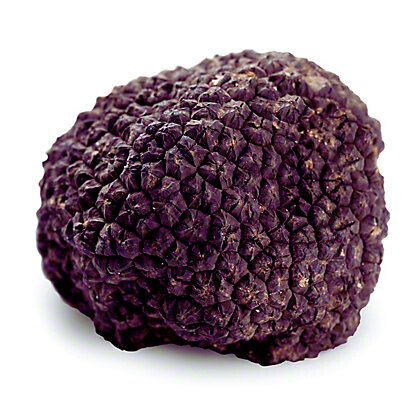
Black truffles, known scientifically as Tuber melanosporum, are highly prized fungi that are renowned for their unique flavor and aroma, which add a luxurious dimension to culinary dishes. These truffles are typically dark brown or black with a rough, knobby exterior. They possess a rich, earthy flavor that is both complex and deeply savory, often described as a mixture of chocolate and soil with nutty undertones, making them a sought-after ingredient in high-end cuisine.
The aroma of black truffles is especially treasured, as it is known to stimulate olfactory discernment, contributing significantly to the overall dining experience. This aroma can enhance the flavor of many dishes, from simple pastas to elaborate meat courses.
Due to their high demand and the challenges associated with cultivating them, black truffles are often expensive. They are typically harvested in the wild from late autumn to mid-winter, mainly in European countries such as France, Spain, and Italy, using trained dogs or pigs to sniff out the truffles, which grow underground in symbiosis with the roots of certain trees.
White Truffles
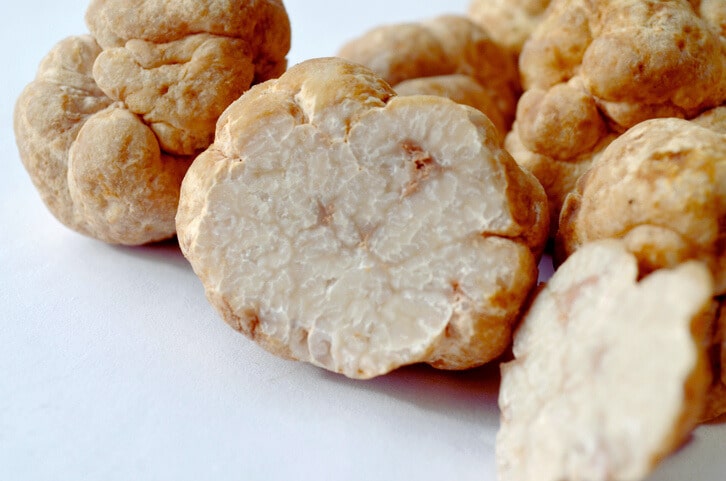
White truffles, particularly the prized Alba white truffle (Tuber magnatum), are among the most cherished and expensive culinary ingredients in the world. They are known for their intense aroma and unique flavor, which can transform a simple dish into a luxurious experience. White truffles have an irregularly shaped, knobby exterior and are usually pale cream to light brown, with white marbling throughout. They thrive near the roots of hardwood trees such as oaks, hazelnuts, and chestnuts.
The allure of white truffles lies not only in their distinctive taste but also in their elusive nature. They can only grow in the wild and have never been successfully cultivated, making them a rare find. Truffle hunters, often accompanied by trained dogs, seek them out in specific regions, adding to the mystique and value of these gourmet treasures.
Summer Truffles
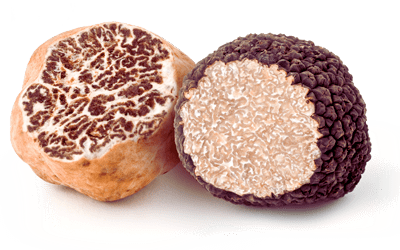
Summer truffles, scientifically named Tuber aestivum, are cherished for their distinctive characteristics and culinary uses. They are identifiable by their roughly ball-shaped fruit bodies, which can reach up to 10cm in diameter. The skin, or peridium, of summer truffles, is black and covered with warts, giving them a unique and coarse texture on the exterior. These truffles are found in almost all European countries, showcasing their wide natural distribution.
Notably less expensive than their winter counterparts, summer truffles provide good edibility and are deemed suitable for daily culinary applications, making them a versatile ingredient in various recipes. Despite their dark and coarse outer appearance, they should not be confused with the more prestigious black truffles, as summer truffles offer a different taste and aroma profile.
Winter Truffles
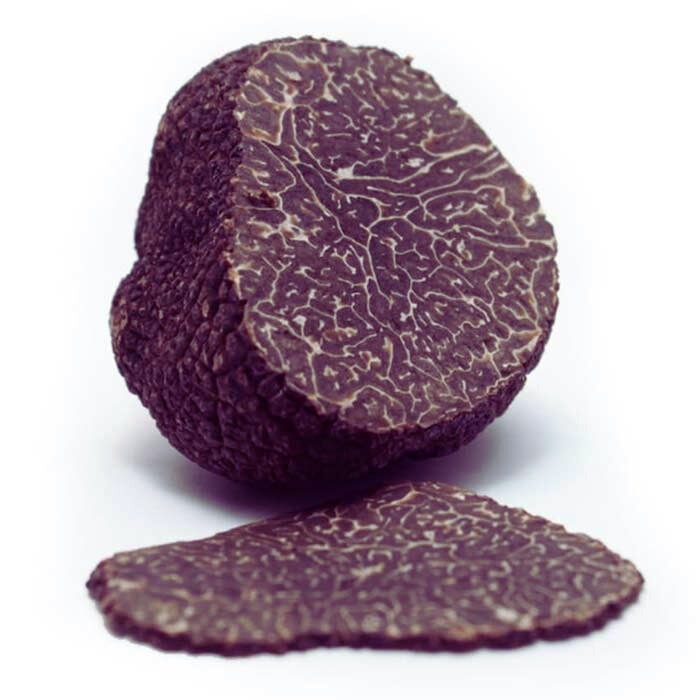
Winter truffles, specifically the Black Winter Truffle (Tuber melanosporum), are among the most sought-after and aromatic varieties. These truffles are known for their rarity and distinctive, highly aromatic qualities. They share similarities with summer truffles but are distinguished by their intense flavor and aroma, which is unmistakable and pungent. The flesh of Black Winter Truffles is initially white and becomes darker over time, characterized by white veins that permeate the flesh. The surface is covered with small pyramidal cusps, and the skin has a black-brown coloration, making it visually distinctive from other varieties. Despite a common perception that winter truffles may have a subtle flavor, their quality, and depth can significantly enhance culinary dishes, marking them as a prized ingredient in gourmet cooking.
The Truffle Hunt

Truffles, rare and valued fungi, are primarily found underground near the roots of certain trees. The process of locating them involves distinct techniques, largely relying on the keen sense of smell of animals or observant humans. The primary methods include:
- Using Trained Animals: Dogs, traditionally, are the most common animals trained to find truffles. They are chosen for their keen sense of smell and the ability to be trained to sniff out the unique aroma of truffles underground. Pigs have also been used historically, particularly for their natural inclination to root for truffles, although dogs are now preferred due to their easier manageability and less likelihood of eating the truffle upon discovery.
- Observing Soil and Vegetation: Truffle hunters also use their knowledge of the environment to locate truffles. This involves identifying the right type of soil and tree roots where truffles are likely to grow. Signs like small changes in the soil surface or specific vegetation patterns can indicate the presence of truffles underground.
- Legal and Ethical Gathering: In places like Italy, there are specific laws and tools prescribed for the ethical collection of truffles, ensuring the sustainability of truffle populations. Tools like a special spade or truffle collector’s spade are used to carefully extract the truffles without harming the surrounding environment.
The Role of Animals
In truffle hunting, animals play a crucial role due to their keen sense of smell, which is vital for locating truffles that grow underground. Historically, both pigs and dogs have been employed for this task, each with its own advantages and challenges.
- Pigs: Traditionally, pigs, especially female pigs, have been used in truffle hunting. Their natural inclination to root for food combined with an excellent sense of smell makes them effective at locating truffles, which emit a scent similar to male pig pheromones. However, a downside to using pigs is their tendency to eat the truffles once found, requiring the handler to be quick to retrieve the truffle.
- Dogs: Dogs, on the other hand, are more commonly used in modern truffle hunting due to their trainability and the fact that they do not have the same instinct to eat truffles as pigs do. Dogs can be trained from a young age to sniff out truffles without the risk of consuming them. This makes dogs a more manageable and versatile option for truffle hunters.
In summary, while both pigs and dogs are effective for truffle hunting, dogs have become the preferred choice in recent times due to their ease of training and handling.
Modern Truffle Hunting
Modern truffle hunting has evolved significantly with technological advancements enhancing traditional methods. Initially, truffle hunting mainly relied on the natural instincts of animals like pigs and dogs. However, the practice has seen considerable changes:
- Technological Integration: The integration of technology in truffle hunting is notable. GPS technology, for instance, has been employed to improve the efficiency of locating truffles. This allows hunters to mark and return to productive sites with greater ease and accuracy.
- Impact of Climate Change: Recent scientific studies highlight how climate change and the increased frequency of droughts are impacting truffle production. This has led to a greater reliance on technology to mitigate these effects, ensuring sustainable truffle hunting practices.
- Evolution of Truffle Hunting Practices: The evolution from relying solely on pigs to now primarily using trained dogs, and incorporating GPS for better tracking, showcases the adaptive nature of truffle hunting in modern times. This shift not only caters to efficiency but also addresses animal welfare concerns associated with using pigs in hunting.
These advancements and changes are shaping the future of truffle hunting, making it more efficient, sustainable, and adaptable to environmental changes.
Truffles in Culinary Use
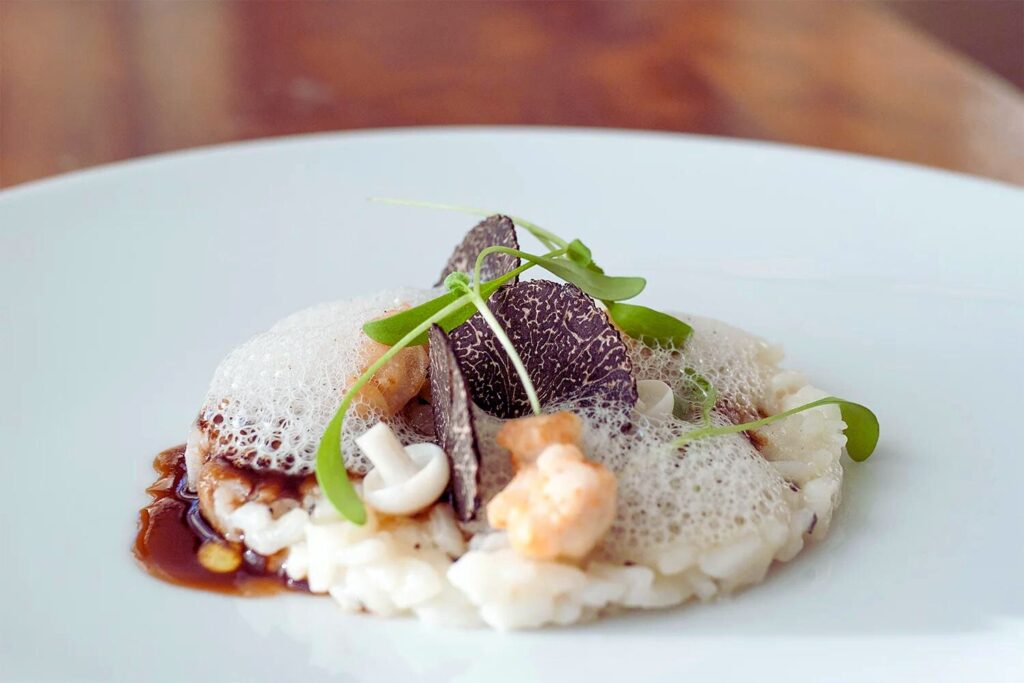
Truffles, a luxury ingredient, are celebrated for their intense aroma and flavor. They find their way into various dishes, mainly in high-end cuisine, enhancing the taste profile with their earthy, musky notes. Here’s how they are commonly used in cooking:
- Pasta and Risotto: Truffles are a classic addition to pasta dishes and risotto, offering a sophisticated depth of flavor.
- Sauces: They can be infused into sauces, imparting a rich, unique taste that complements a variety of dishes.
- Seafood and Meat: Truffles are grated over seafood and meat, especially steaks, to elevate the overall flavor experience.
- Eggs: Adding truffles to scrambled eggs or omelets brings a luxurious touch to breakfast or brunch.
- Truffle Butter: Homemade truffle butter can be spread on bread or melted over steaks for an indulgent treat.
- Garnishing: Often used as a garnish, truffles add a final touch of elegance and flavor to dishes.
Their use is not standalone but as an ingredient or garnishment that complements and enhances the primary flavors of a dish.
Storing and Preparing Truffles
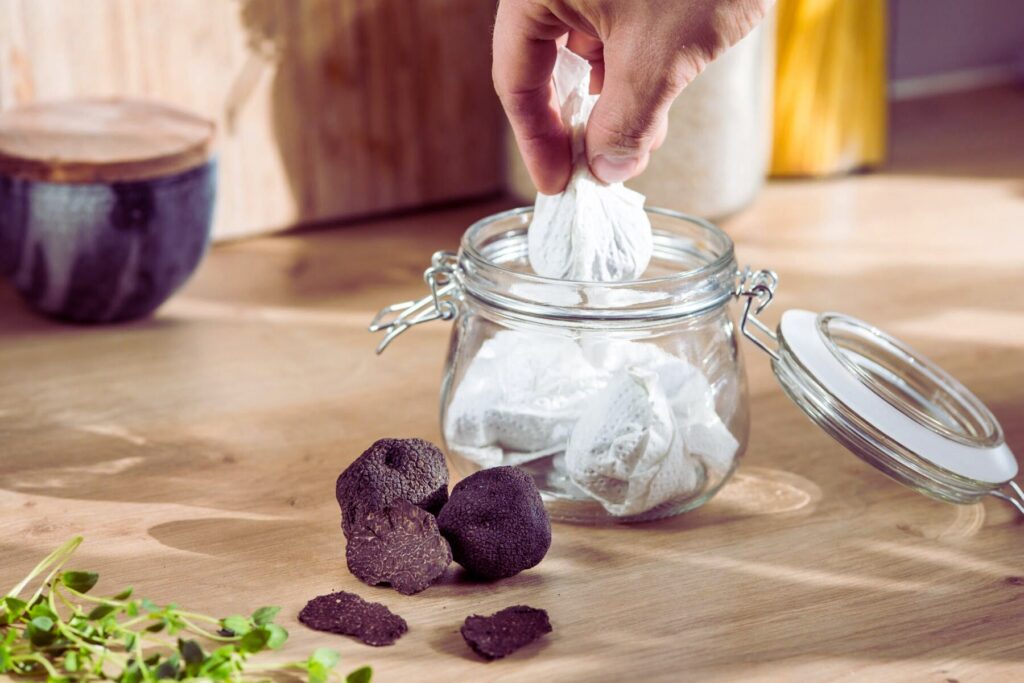
Proper storage and preparation of truffles are key to maintaining their exquisite aroma and flavor. Here’s how to care for your truffle treasures:
Storage:
- Short Term (1-3 weeks): Store truffles in the fridge. For optimal preservation, wrap them in absorbent paper (like a paper towel) and place them in a dry, sealed container, such as Tupperware or a glass jar.
- Long Term: Truffles can be stored in olive oil, which also becomes infused with truffle flavor, offering a dual benefit.
Preparation:
- Before Use: It’s advised to clean truffles by gently brushing off any dirt. Some sources recommend avoiding water, but if necessary, briefly rinse and immediately dry them to prevent moisture from compromising their quality.
- Aroma and Flavor Preservation: Note that truffles lose their aroma and flavor over time, even with optimal storage. They are best enjoyed as fresh as possible.
Popular Truffle-Flavored Dishes
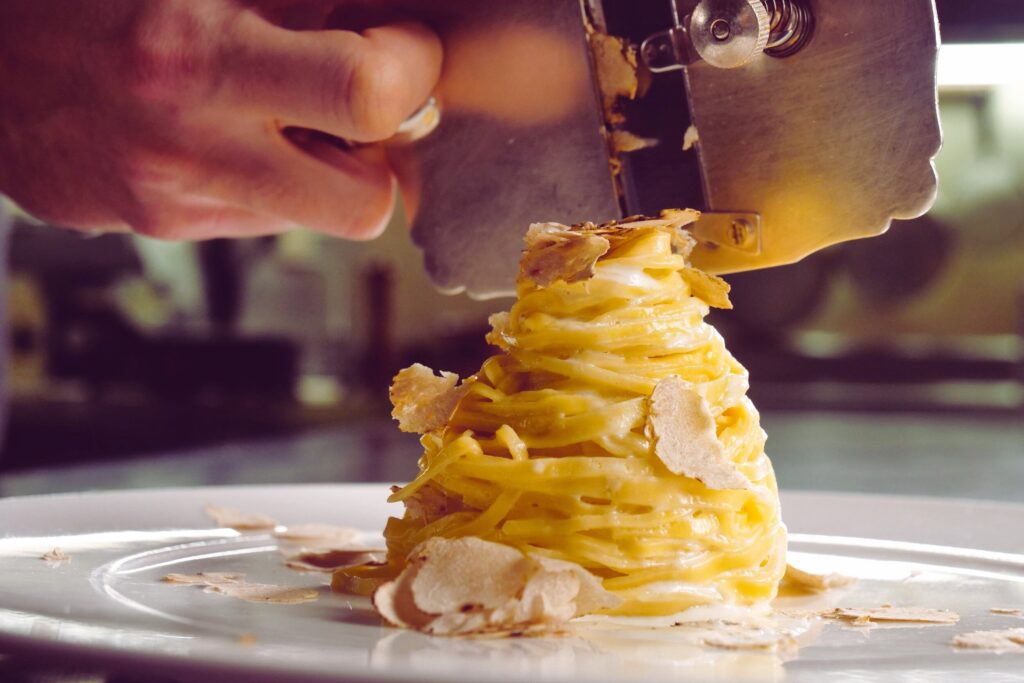
Truffles add a luxurious depth to many dishes, elevating their flavor profile with their distinctive earthy and aromatic qualities. Here are some popular truffle-flavored dishes that showcase the versatility of truffles in culinary use:
- Truffle Lovers’ Popcorn: A gourmet twist on a classic snack, infused with truffle oil for an indulgent experience.
- Truffled Mashed Sweet Potatoes: Sweet potatoes mashed to perfection with a hint of truffle flavor, making a rich and decadent side dish.
- Juicy Gourmet Burger Sliders: Mini burgers enhanced with truffle oil, combining luxurious taste with casual dining.
- Truffle Bruschetta: A sophisticated take on the classic Italian starter, topped with truffle oil or fresh truffle slices.
- Parmesan Truffle Fries: French fries tossed in truffle oil, Parmesan, and herbs, offering a fragrant and savory treat.
- Grilled Cheese with Truffle: Elevating the classic grilled cheese sandwich by incorporating truffle oil or shaved truffles for a rich and decadent flavor.
These dishes illustrate just a few ways truffles can be incorporated into both simple and sophisticated recipes, adding a touch of luxury to everyday meals.
The Economics of Truffles
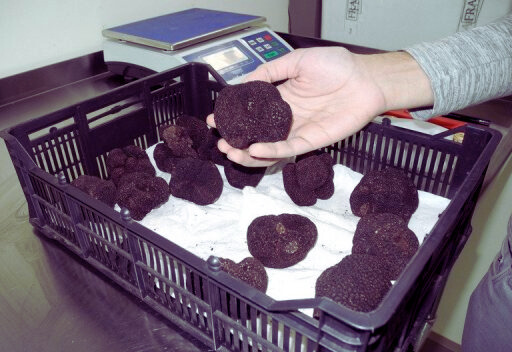
The truffle market is a luxurious segment within the food industry, characterized by high demand and limited supply, which significantly influences its economics. As of 2023, the truffle market was valued at approximately $360 million and is projected to grow to $810 million by 2030, showcasing a Compound Annual Growth Rate (CAGR) of 9.1%. This growth is driven by several factors, including the exclusivity of truffles, their unique flavor, and their culinary prestige. The valuation of the truffle market in 2022 stood at around $0.91 billion, with expectations to witness a CAGR of over 8.5% from 2023 to 2032.
Truffles are notoriously difficult to cultivate and harvest, contributing to their high market value. The demand for premium truffle species far outstrips supply, a factor of ten according to some estimates, due to their challenging cultivation. This scarcity and high demand have fostered a robust economy around truffles, making them one of the most prized and expensive ingredients in the culinary world.
Why Are Truffles So Expensive?
Truffles command high prices for several interconnected reasons:
- Rarity and Seasonality: Truffles are rare, with some varieties being exceedingly scarce. Their availability is limited to specific seasons, and they have a short shelf life, which further contributes to their exclusivity.
- Difficulty in Cultivation and Harvesting: Truffles cannot be easily farmed like other crops. They grow underground, attached to the roots of certain trees in very specific conditions. Harvesting them requires trained animals, such as pigs or dogs, making the process labor-intensive and costly.
- High Demand: Despite their high price, there is a strong demand for truffles in the culinary world. Their unique flavor is highly prized by chefs and gourmets, further driving up prices.
- Culinary Value: Truffles add a unique and intense flavor to dishes, which cannot be replicated with other ingredients. This unique culinary value makes them highly sought after in high-end cuisine.
Truffles Around the World
Truffles are esteemed worldwide, not just for their unique flavors but also for their cultural significance and historical value. Here’s how different cultures appreciate truffles:
- Europe: Truffles have long been a symbol of luxury in European gastronomy, especially in France and Italy. The white truffle from Alba, Italy, and the black truffle from Périgord, France, are particularly celebrated, fetching high prices in markets and restaurants.
- Middle East and North Africa: In Islamic culture, truffles are valued for their nutritional and health benefits. They have been used traditionally for their medicinal properties and are a key part of the regional cuisine.
- Global Delicacy: Across the world, truffles are considered a delicacy, enjoyed in a variety of culinary applications. Their rarity and the labor-intensive process of harvesting them contribute to their status as one of the most expensive foods globally.
- Cultural Myths and Legends: Truffles have fascinated people around the world, with various myths and legends surrounding their origins and powers. This has only added to their allure and mystique.
The Future of Truffles
The future of truffles looks promising, with significant growth expected in the global truffle market. This optimism is driven by a growing demand for luxury food experiences and unique flavors. The market size, valued at several million in 2022, is anticipated to expand considerably by 2030, showcasing a notable compound annual growth rate (CAGR). Climate change, interestingly, might play a beneficial role for truffles, especially for species like the Burgundy truffle. Predictions suggest that the cultivation potential for truffles in central Europe and possibly new regions will increase by 2050 due to climate shifts. This indicates that while truffles remain a symbol of culinary luxury, their increased availability might make them more accessible to wider audiences, thus broadening their market even further.
Conclusion
Truffles captivate with their mystique and rarity, commanding the culinary world’s attention and admiration. As mycorrhizal hypogeous fungi, truffles require specific pedoclimatic conditions and a symbiotic relationship with their host plants, underscoring their elusive nature. Their cultivation, while achievable, remains a topic of debate regarding whether it can match the allure and taste of their wild counterparts. Beyond their enigmatic appeal, truffles are also celebrated for their health benefits, being rich in important nutrients, vitamins, and minerals, and possessing antioxidant properties that may support overall health and reduce the risk of chronic diseases. This combination of rarity, flavor, and nutritional value cements truffles as a highly prized and important element in both gastronomy and nutrition.
Read also: What Are Skinwalkers?
FAQs
Q. What exactly are truffles?
Truffles are a type of edible fungi that grow underground, close to the roots of certain trees. They’re known for their strong aroma and distinctive flavor, which can enhance a variety of dishes.
Q. Why are truffles so expensive?
Truffles are costly due to their rarity, the difficulty of harvesting them, and their high demand in gourmet cooking. Each of these factors contributes to their luxury status and price.
Q. How do you find truffles?
Truffles are traditionally found with the help of pigs or dogs, which are trained to detect the strong aroma of truffles beneath the soil. Modern methods also include the use of technology to identify potential truffle-growing areas.
Q. Can I grow truffles at home?
While it’s theoretically possible to cultivate truffles, it requires specific conditions, including the right type of soil and trees, as well as a lot of patience, since truffles take several years to mature.
Q. How should truffles be stored and prepared?
Truffles should be kept in the refrigerator, wrapped in paper towels and placed in an airtight container. Before use, they should be cleaned with a soft brush and can be shaved, grated, or sliced thinly to enhance dishes.
